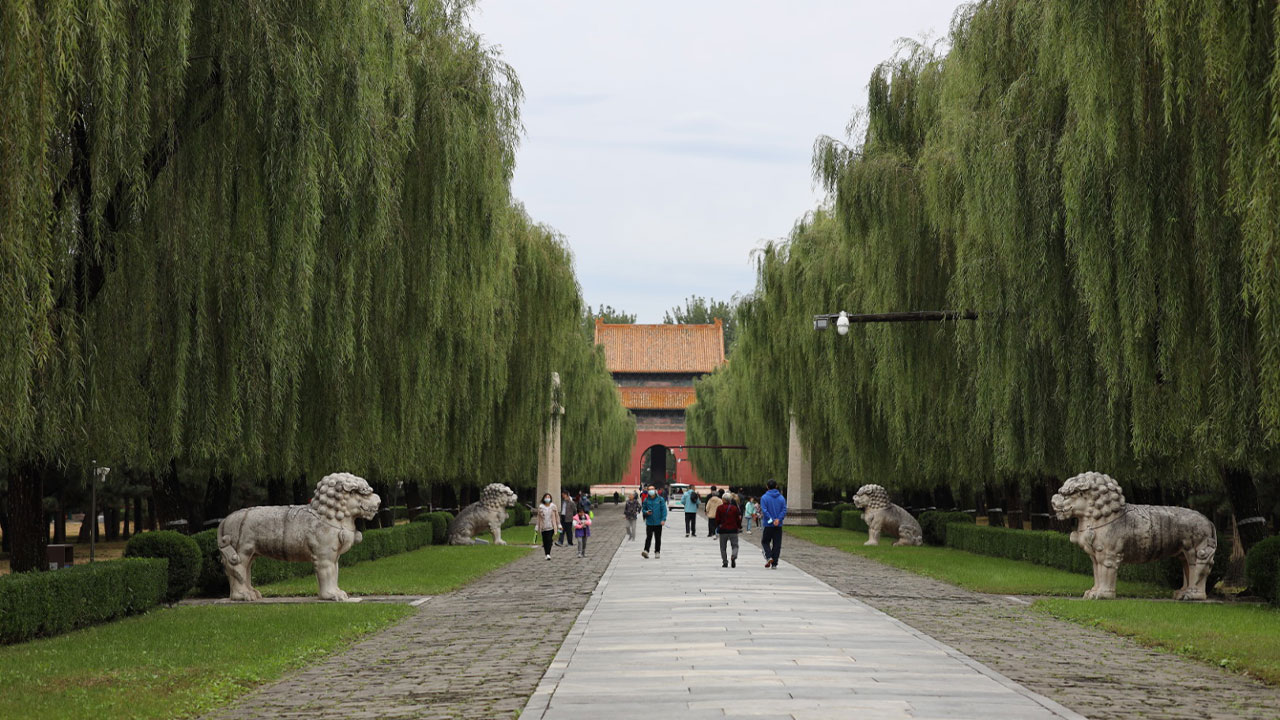Ming Tombs

There are thirteen imperial tombs of the Ming Dynasty scattered at the foot of Tianshou Mountain in Changping district, some 50 kilometers northwest of Beijing.
Construction of this complex continued for more than 200 years from 1409. Each of the 13 tombs is located at the foot of a hill and has a separate layout. Each is linked with the others by a road called the Sacred Way. And it is the largest mortuary complex in China. The tombs show a classic elegance and splendor that is overwhelming. The design manifests a clear order of importance and precedence.
The outermost point of the mortuary complex is a huge marble archway supported by six pillars. Built in 1540, it is 14 meters high and 28.86 meters wide and provided with five arches and 11 tower-like decorations. It is the largest extant archway in China. In feudal China, archways were used to advocate the feudal code of ethics, symbolize power, or promote philanthropy.
Each of the 13 Ming tombs has its special features, but a standard layout is common to all.
Of the 13 tombs, Changling (tomb of Emperor Yongle) is best-known for its magnificent architecture and Dingling (tomb of Emperor Wanli) for its under-ground palace. Lying at the foot of the central peak of the Tianshou Mountain, Changling contains the remains of Emperor Yongle and Empress Xu. The first and largest of the 13 tombs, it was built in 18 years. In front of the burial mound is an imposing Palace of Ling’en where sacrifices were offered to the deceased emperor. The hall has a double roof and is 66.75 meters wide and 29.31 meters deep. It is also called Nanmu Hall because its ceiling is supported by 32 gilded nanmu (a fine hardwood) pillars and the beams, purlins and rafters all consist of the same material. Each of the four largest pillars, 14.3 meters high and 1.17 meters in diameter, was shaped out of a single nanmu trunk.
Dingling is the tomb of Emperor Wanli and his two empresses. It was built in six years at a cost of 8,000,000 taels of silver. The highlight of this tomb is its underground palace. Occupying an area of 1,195 square meters, the underground palace consists of the antechamber, the central chamber, the rear chamber, and left and right annexes. All are vaulted stone structures built without a single beam or column. In the central chamber are three white marble throne seats for the emperor and his two empresses, and before each seat is a set of five objects — an incense burner, two candlesticks and two vases, all of yellow glazed pottery, plus an “eternal lamp,” a bronze bowl with a floating wick. More than 3,000 objects have been unearthed from the underground palace, among which are such treasures as Emperor Wanli’s gold filigree crown decorated with two dragons playing with a pearl and the empresses’ phoenix crowns.
The Ming Tombs are home to a lot of history and culture. The ground structure carries much ritual significance, and the burial chamber is built as a solemn stone palace with a gateway and thrones.
The Ming Tombs, as an important part of the royal mausoleums from the Ming Dynasty, are not only a treasure of ancient Chinese architectural art, but also an important carrier of the culture and history of the Ming Dynasty, which embody the characteristics and achievements of the Ming renaissance in many aspects.
I. Revival in the art of architecture
The Ming Tombs feature a rigorous architectural layout and a grand scale. The mausoleums exhibit different architectural styles, yet all reflect the majestic and solemn nature of Ming dynasty royal architecture.
Dingling's underground palace is in accordance with the pattern of the palace inner court building design, before, in, after the three halls and the Forbidden City's after the bedchamber part of the match, the left and right halls are also with the Forbidden City's East six palaces, West six palaces, which embodies the high development of architectural art in the Ming Dynasty.
Ⅱ. Revival in Stone carvings and stone carvings:
Inside the Ming Tombs, there are a large number of stone carvings and stone carvings, which are skillful and of high artistic value.
These stone carvings and stone carvings not only show the Ming Dynasty craftsmen's superb skills, but also reflects the Ming Dynasty society's emphasis on art and the pursuit.
III. Embodiment in the social system
The Ming Tombs, as an important part of the royal mausoleums of the Ming Dynasty, its construction and management followed a strict royal mausoleum system. These systems not only reflect the honored status of the Ming royal family, but also reflects the importance of the Ming society on etiquette and hierarchy.
The Ming Tombs embodies the characteristics and achievements of the Ming revival in many aspects, including architectural art, cultural heritage and social system. It is not only a treasure of ancient Chinese architectural art, but also an important carrier of the culture and history of the Ming Dynasty, which is of great significance for the inheritance and promotion of Chinese culture. The Ming Tombs were listed as a World Heritage Site in 2003.